SOSYO-POLİTİK ŞİA’DAN TEO-POLİTİK ŞİÎLİĞE EVRİLEN SÜREÇ
THE EVOLVING PROCESS FROM SOCIO-POLITICAL SHIA TO TEO-POLITICAL SHIITE
At the present time, when the concept of Shia is used in Islamic literature, its connotation and the use of the word in the Quran as the main source of the religion of Islam have different meanings. The claim of governance as a social issue was not limited to the society in which it emerged in the historical process, but also gained a religious meaning by transcending the boundaries of the administrative sphere. The concept that appears in Islamic terminology in the fields of theology, fiqh, philosophy, sect history, Sufism, and political history has been discussed in a broad framework. After the death of the Prophet, the word in the composition of “Şiatü Ali”, which was used to mean Ali support, gained a new meaning independent of the composition with the changing conditions. Intellectual interpretation disputes in the administrative center within the boundaries of Madinah found a new direction with its influence on social and political conditions at the end of the period of sectarianization, which was completed by forming its own systematic. Having gained a new structure with the concept of imamate, Shia, apart from the Sunni structure, formed its own center against all conflicts within it. In this study, the factors affecting and influencing this change process were evaluated.
___
- Cleveland, William L. (2008), Modern Ortadoğu Tarihi, Agorakitaplığı.
- Cooper, John.(2005), “Safevî İran’ının Dini Entelektüel Ortamı Üzerine Bazı Mütalâalar”, İslam’da Entelektüel Gelenekler, Farhad Daftary, İnsan Yayınları, İstanbul.
- Corbin, Henry (2001), İslam Felsefesi Tarihi, İletişim Yayınları.
- Cübran, Mesud (1992), el-Raid, Darü’l İlm li’l-Melayin, Beyrut.
- Çayıroğlu, Yüksel (2013), “Ehl-i Sünnet ile Şia Arasındaki Temel İhtilaf Noktaları”, Dicle Üniversitesi İlahiyat Fakültesi Dergisi, cilt 15, sayı:1, s.199-243.
- Çelenk, Mehmet (2013), “Safeviler Döneminin Şiî-Sünnî İlişkileri Üzerindeki Etkisi”, e-makâlât Mezhep Araştırmaları, VI/2 (Güz 2013), s.63-85.
- Çelenk, Mehmet (2014), “Safevîlerin Din Politikası ve İran’ın Şiîleşme Seyri”, Çanakkale Onsekiz Mart Üniversitesi İlahiyat Fakültesi Dergisi, Sayı 4, s.7-35.
- Çınar, Gülay Karadağ (2017), “Safevi Devleti’nde Dini Otoritenin Temsilcisi Şahlar ve Şii Ulemayla İlişkileri”, İran Çalışmaları Dergisi, c.1, s.1, s.11-51.
- Daftary, Farhad (2016), Şii İslam Tarihi, Alfa.
- Dalkıran, Sayın (2000), “İran Safevi Devleti’nin Kuruluşuna Şii İnançların Etkisi ve Osmanlı’nın İran’a Bakışı”, Atatürk Üniversitesi İlahiyat Fakültesi Dergisi, Yıl. 2000, S.18, s.49-96.
- Ekinci, Ahmet (2019), “Caferi Fıkhının Doğuşu ve Dönemleri”, İslam Hukuku Araştırmaları Dergisi, sy. 33, s.523-546.
- El-Küleynî (2007), Usulu’l-Kafi, c.1, Menşuratu’l Fecr, Beyrut.
- El-Nevbahti (2012), Fıraku’l Şia, Menşurat el-Rıda, Beyrut.
- Gellner, Ernest (2018), Uluslar ve Ulusçuluk, hil yayın.
- ISSN: 2636-803X
- Yayın Aralığı: Yılda 2 Sayı
- Başlangıç: 2018
- Yayıncı: Aziz TUNCER
Sayıdaki Diğer Makaleler
JOSEPH SCHUMPETER’İN REKABETÇİ DEMOKRASİ MODELİNİ ÇOĞULCULUK BAĞLAMINDA YENİDEN DÜŞÜNMEK
SOSYO-POLİTİK ŞİA’DAN TEO-POLİTİK ŞİÎLİĞE EVRİLEN SÜREÇ
Aznavur DEMİRPOLAT, Mehmet ERGÜL
TURKEY’S SECULARISM EXPERIMENT AS AN IMPEDIMENT TO DEMOCRATIC CONSOLIDATION
COVİD-19 İLE MÜCADELEDE DÜNYADA AKILLI KENT UYGULAMALARINA İLİŞKİN BİR DEĞERLENDİRME
THE ABE ADMINISTRATION AND THE JAPAN CONFERENCE: AN UNFULFILLED PROMISE TO MAKE JAPAN GREAT AGAIN
